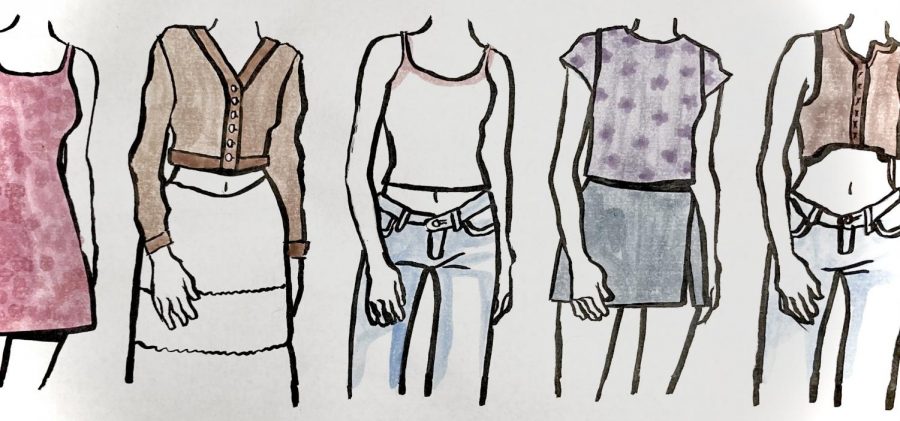The Harmful Effects of Brandy Melville’s Marketing Strategy
January 29, 2021
It’s likely you’ve heard of Brandy Melville, the Italian fast fashion brand that’s gained increasing popularity among American teenagers. They are known for their simple yet trendy clothes and their unique aesthetic, which is both recognizable and controversial. Everybody knows the quintessential “Brandy girl”: effortlessly beautiful, always in style, but most importantly, she is thin.
The clothes at Brandy range from size extra small to small, otherwise known as “regular,” and only fit very thin girls. The largest size sold is “oversized,” which makes it even more clear who they want wearing their clothes. The one size policy is extremely controversial and has left many girls feeling insecure, unworthy, and unattractive. However, given the amount of criticism they recieve, Brandy Melville has still managed to thrive; they have an Instagram page with 3.6 million followers, 95 locations worldwide, and an annual growth rate of nearly 25 percent.
How is it that a company that only caters to a tiny portion of the population can gain such a large following of teenage girls? The answer lies in the marketing, which is just as genius as it is cruel. Brandy Melville employs different strategies than a typical fashion company; they use minimalistic photo shoots and a laid back atmosphere to make their brand feel more down to earth and relatable to the teenagers that shop there. The employees often perform as the models and photographers for the Instagram page and website, and many have large social media followings of their own, which they use to further promote the company. Using employees as models and photographers for the photoshoots not only cuts the cost that the company would otherwise have to pay professionals, but it also makes the cool girl look promoted by Brandy Melville seem more attainable. The girls who shop there don’t see professional models as the face of the brand, rather young girls who are just like them, just the trendier and cooler version that they strive to be. It’s important to note that the employees at Brandy usually come directly out of the customer pool, and most are teenage girls themselves who were scouted while shopping.
Over the past five years, it has become popular for brands to represent a wider range of consumers in their marketing; many companies actively promote plus size and BIPOC models in their campaigns, giving confidence to people who don’t normally see themselves in mainstream media. However, Brandy Melville actively rejects any step towards progress, instead choosing to only promote and hire the girls who fit within their look: skinny, conventionally pretty, and more often than not, white. This tactic makes their brand extremely exclusive, and is perpetuated over and over again in their marketing. Because Brandy’s target demographic is young girls, they are able to perfectly tune into the internalized desire to fit in and be skinny that’s prominent within that age group. The exclusivity validates girls who fit into the clothes and invalidates those who don’t, as they start to wish that they could be small enough to belong. The impact is vast, and damages the self-confidence of many teenage girls. When asked about her thoughts on the store, Sarah Berhanu ’22, told the Register Forum, “The appearance that they were advertising just made me judge myself more and made me want to fit in more.” While not everybody possesses the physicality of a Brandy model or employee, many young girls are led to believe that by purchasing the clothes, they can have the lifestyle of one; trendy, desirable, and uncomplicated.
The environment of the stores themselves can be unfriendly, as sometimes the employees are perceived to be unwelcoming. This can create a hierarchy among the girls who shop there, as most are trying to meet the unattainable goal of effortlessly fitting the look. Those who do fit in receive instant validation with the compliments of the employees, pants that fit, and the possible job offer. Those that don’t gravitate towards the accessories section and leave feeling worse than when they came in. At the same time, the girls who fit the look are subject to the bitterness of people who have been made to feel bad about themselves, or the valid backlash that should get directed at the people who created the negative environments. It’s no surprise that a brand that only labels one type of person as desirable has an unwelcoming culture within their stores; after all, the company is built off of exclusivity. However, the larger problem is with the corporate side of Brandy, who are profiting off of both the cheap labor and free promotion they get from employees, just as much as they are from the shopping habits of their consumers. The teens who are the face of Brandy Melville are often the target of the aggressive criticism that needs to be placed on the company as a whole, not the employees.The employees and consumers are two sides of the same coin, teenagers hoping to sit at the cool table during lunch, and the higher ups of the company know exactly how to exploit this: giving some of the girls a seat, while leaving the others to try even harder to gain a selective spot they may never get. All the while, the male CEO is gaining more publicity and making more money, profiting off of the sexist system of assigning worth to girls based off of their appearance.
The issue is not with people who chose to shop at Brandy Melville, nor is it fully with the employees and models. The issue is with a system that puts girls against each other by labeling some as worthy and others as not, purely based on physical appearance. The intrigue of Brandy Melville is hard to shake, and no matter how much hate they recieve, they won’t change. The fact that a brand owned by men, who actively and unashamedly profit off of the insecurities of teenage girls, is deeply disgusting, unarguably sexist, and shows the damaging origins of the beauty expectations women are subject to.










